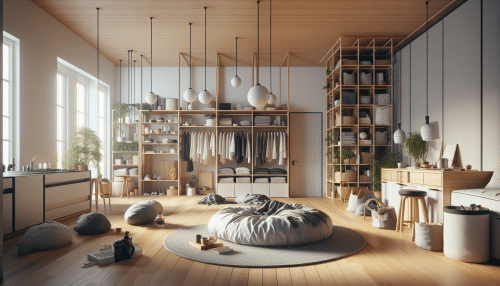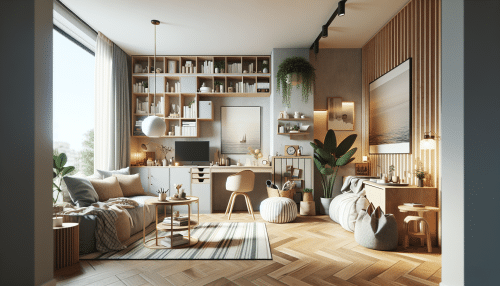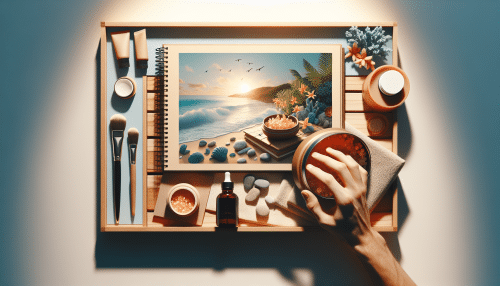Minimalist Living Ideas That Transform Your Everyday Life
Olivia Morgan November 25, 2025
Discover how minimalist living influences happiness, financial wellness, and your environment. Explore practical minimalist home design principles and proven benefits, plus get insight on decluttering tips, mindful consumption, and the psychology behind less-is-more.
Why Minimalist Living Appeals to So Many People
Minimalist living has seen a sharp rise in popularity, especially among those searching for more happiness and simplicity in their day-to-day routines. The growing interest can be traced back to a desire for less clutter, more freedom, and improved well-being. By cutting out distractions, many individuals have discovered that minimalist home design is more than a trend—it helps reshape habits and priorities. The appeal also comes from a wish to focus resources only on the essentials, creating space for more fulfilling experiences and relationships. Living with less isn’t always easy, but the deeper purpose of minimalist living offers meaningful rewards that positively influence both mental health and finances. Exploring the roots of minimalism often uncovers psychological motivations for why letting go can feel liberating.
Many find that the psychological benefits of minimalist living extend to every aspect of their lives. Reducing possessions can minimize stress, boost mood, and strengthen focus. It’s not about giving up comfort—it’s about creating a mindful home environment that allows you to relax fully. When your physical space becomes less cluttered, studies show your mind experiences fewer distractions and you’re able to concentrate better. Minimalist routines also support self-care by ensuring that each chosen item or activity genuinely adds value. This mindset shift is crucial for those battling decision fatigue, where too many options often feel overwhelming. Embracing this lifestyle helps streamline everything from choosing clothes to planning your workday, making every moment matter more.
The eco-friendly aspect of minimalist living shouldn’t be overlooked. Mindful consumption means less waste, fewer purchases, and more thoughtful maintenance of existing possessions. When buying new, advocates aim for high-quality, long-lasting items—reducing environmental impact while improving everyday satisfaction. For many, downsizing and decluttering is not a temporary phase but a lasting lifestyle choice rooted in sustainability and ethical consumerism. It’s a journey toward intentionality, with every step offering small shifts that collectively lead to a lighter, happier way of living. Minimalist living transforms not just spaces, but also the mindsets of individuals dedicated to living more with less.
Decluttering Techniques for a Minimalist Home Design
Effective decluttering is central to minimalist home design, providing the foundation for a peaceful and efficient living environment. Many experts recommend starting with the easiest category—such as clothes—before moving on to books, paperwork, and sentimental items. Sorting each item by its usefulness and joy factor is pivotal. The goal isn’t just to throw away, but to thoughtfully curate what truly belongs in the home. It can be surprising to discover that a clutter-free environment lessens daily stress and increases motivation for self-improvement. Over time, people find it easier to maintain a tidy home because large clean-ups become unnecessary with less stuff in general. The decluttering process fosters habits that align with mindful consumption and practical design.
An organized approach simplifies decluttering further. Creating designated zones in the home allows for efficient cleaning and organization. Storage solutions such as hidden shelves, multi-purpose furniture, and clearly labeled containers prevent the slow return of clutter. Minimalist home design also emphasizes keeping surfaces clear and floors unobstructed, which encourages regular maintenance of these tidy spaces. With fewer items out in the open, every piece—from decorative objects to daily tools—can be intentionally appreciated. Bringing order into the home in this way not only enhances visual beauty but also promotes a calm mindset and a feeling of control. Minimalism favors purposeful spaces over filled ones, encouraging residents to design according to their genuine needs.
The psychology behind decluttering reveals even deeper benefits. Studies indicate that tackling physical clutter helps reduce anxiety, sharpen attention, and create a sense of accomplishment. It’s not simply about aesthetics: the symbolic act of discarding or donating excess can empower individuals to let go of emotional baggage too. Minimalist home design is often paired with techniques like gratitude journaling or mindful meditation, which reinforce the connection between external order and internal peace. The minimalist’s mantra isn’t about what’s missing, but rather about what truly matters. Over weeks and months, even small changes add up—transforming routines and the atmosphere of home.
Mindful Consumption as a Pathway to Happiness
Minimalist living naturally leads to mindful consumption—a deliberate approach to how goods and services are chosen. Instead of seeking quick gratification, proponents look for enduring value and function in every purchase. This slow, thoughtful method frequently saves money, lowers debt, and drives contentment in the long run. By considering not just what to buy but why and how it will be used, individuals become more aligned with their core values. Mindful consumption challenges short-term thinking and trends, reinforcing a preference for the sustainable, ethical, and lasting. Many who shift their habits in this way report greater satisfaction and fewer financial regrets. The focus moves away from possessions as markers of success toward experiences and relationships.
One key aspect of mindful consumption is assessing whether an item brings real utility or joy. Minimalists often find practical questions helpful: is this truly needed? Will it serve a clear purpose? Will it last? This approach encourages selectiveness, which can subsequently lead to higher self-esteem. Buying fewer, better things supports local artisans, eco-friendly brands, and ethical businesses. What feels right for each person may differ, but the outcome—a home and lifestyle designed with intention—is remarkably similar. Mindful consumption aligns closely with minimalist living values, turning every transaction into a meaningful investment in happiness, well-being, and even community impact.
Digital consumption is another sphere that benefits from a minimalist, mindful approach. Many people are surprised by how digital clutter—from saved emails to phone apps—affects well-being. Decluttering digital spaces can bolster productivity, reduce stress, and promote focus on what really matters. Minimalists recommend regularly clearing inboxes, limiting social media time, and curating online subscriptions. With less noise in the digital realm, there’s greater opportunity for genuine connection and creativity. Minimalist living reinforces a holistic sense of happiness, balancing both physical and virtual worlds through conscious choices.
Designing a Minimalist Space: Tips and Tricks
Minimalist home design centers on simplicity, function, and open space. Neutral color palettes, natural light, and uncluttered surfaces enhance a serene ambiance. Furniture should serve multiple purposes wherever possible—a storage ottoman, for instance, pairs function with elegance. Designers also advocate for incorporating greenery or art sparingly to enrich without overwhelming. Selecting statement pieces and leaving plenty of breathing room prevents overstimulation and allows key elements to stand out. The ultimate aim is to create rooms that exude peace, not emptiness. Residents often express greater satisfaction in spaces that encourage mindful movement and easy navigation.
Lighting is foundational to any minimalist home design. Natural light not only opens up a room but boosts mood and productivity. Strategically placed mirrors multiply light and add depth. Window coverings should be lightweight and easy to adjust, preventing rooms from feeling crowded. Texture—including natural wood, woven fabrics, and smooth ceramics—adds warmth and visual interest without clutter. Minimalist living is less about eliminating everything than about keeping what is beautiful or practical. Art and accessories serve deliberate purposes, supporting the calm, curated feel that defines modern minimalist spaces.
Personalization factors significantly into successful minimalist home design. While the overall look may be spare, meaningful items—family mementos, favorite books, or plants—create emotional resonance. It’s important to design around routines and lifestyle needs, making minimalism flexible rather than rigid. For example, a work-from-home space might include ample storage tucked behind closed cabinets to keep distractions low. Creating drop zones for bags, mail, or shoes near entryways prevents messes from spreading. Minimalism, in this sense, isn’t one-size-fits-all but an adaptable philosophy that grows with household shifts and changing tastes.
The Psychological Benefits of Living With Less
Research consistently links minimalist living with increased happiness, lower anxiety, and enhanced self-awareness. Minimalist environments support fewer distractions, which in turn create better rest and focus. For many, paring down possessions is a key step toward building confidence and autonomy. Letting go of excess cultivates an appreciation for what remains, allowing simple joys to become more pronounced. Science has also drawn connections between orderly living spaces and improved cognitive performance. These findings reinforce the idea that the minimalist lifestyle isn’t just an aesthetic preference, but a transformative mental health strategy.
Simplifying daily routines through minimalist living often leads to more free time and stronger relationships. With less time spent on housework or shopping, individuals can prioritize face-to-face connection and personal growth. Emotional resilience benefits, too—minimalists find it easier to navigate changes, adapt to loss, and manage stress. Focusing on what truly matters provides a foundation of gratitude that colors all aspects of life. This mindful approach extends from home design to financial decisions and even the way one participates in community.
Mindfulness is a core principle underpinning the psychological benefits of minimalism. By choosing possessions, relationships, and activities with care, individuals experience heightened satisfaction and a sense of clarity. The journey isn’t without difficulties, as letting go of sentimental items or past habits can be emotionally charged. Yet over time, the reduced mental load and lighter surroundings add up. Minimalist living is, at heart, a commitment to living with purpose—and the rewards, from serenity to adaptability, echo throughout a person’s everyday life.
Minimalist Living Beyond the Home: Social and Global Impact
The effects of minimalist living ripple outward to social circles and communities. Choices around mindful consumption, waste reduction, and ethical shopping can inspire those nearby to reflect on their own habits. Many minimalists find themselves advocating for sustainability, local sourcing, and communal sharing. The benefits of minimalist design in public places—like libraries or cafes—suggest that simplicity and function can promote relaxation and creativity everywhere. Collective adoption of minimalist values could lead to a more equitable use of resources and a healthier planet.
Minimalist living often intersects with broader social movements. For example, eco-conscious individuals integrate zero-waste and Buy Nothing practices, reducing landfill contributions while supporting local economies. Social media platforms and online forums allow sharing of decluttering journeys, mistakes, and best practices—creating a sense of community even among strangers. Minimalist principles encourage thoughtful giving, volunteering, and resource pooling, shaping social interactions with greater empathy and intention. These habits create positive feedback loops that keep minimalist living dynamic and practical.
Globally, the simplicity of minimalism resonates with environmental priorities and the growing need for sustainable development. Governments and NGOs sometimes promote minimalist living as a route to resource efficiency and reduced carbon footprints. The movement is not without critics, who highlight issues of accessibility and cultural context; nonetheless, even small adoptions of minimalist habits—such as reducing fast fashion or reusing goods—can have significant impact. Minimalist living is thus both an individual journey and a potential catalyst for broader social change—one mindful choice at a time.
References
1. Kondo, M. (2014). The Life-Changing Magic of Tidying Up. Retrieved from https://www.nytimes.com/2014/11/02/books/review/the-life-changing-magic-of-tidying-up-by-marie-kondo.html
2. American Psychological Association. (2021). Why Decluttering Reduces Stress. Retrieved from https://www.apa.org/topics/mental-health/clutter-declutter
3. The Minimalists. (n.d.). 16 Rules for Living with Less. Retrieved from https://www.theminimalists.com/rulebook/
4. BBC Future. (2019). The Benefits of Minimalism. Retrieved from https://www.bbc.com/future/article/20190612-minimalism-why-do-some-people-want-less-stuff
5. Good Housekeeping. (2022). How to Embrace Minimalist Design. Retrieved from https://www.goodhousekeeping.com/home/decorating-ideas/a19444790/minimalist-home-decor
6. National Institutes of Health. (2020). Clutter, Stress, and Your Mental Health. Retrieved from https://newsinhealth.nih.gov/2020/03/clear-your-clutter





